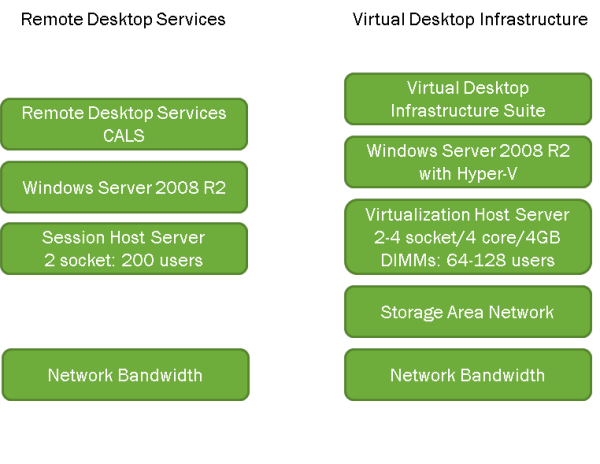We have looked at the benefits of desktop virtualization in Small Business Endpoint Virtualization - Smartphones, Tablets And PCs and what two flavors of desktop virtualization are in What is Desktop Virtualization? VDI vs. Session Virtualization. Now we will answer the question, how does desktop virtualization work to improve productivity.

We will again stick to VDI and session virtualization, both forms of remote desktop virtualization in which the virtual environment is running on a server. Session virtualization (formerly terminal services) uses Remote Desktop Services. In this scenario, all programs are installed on the server and users submit input through a keyboard, mouse (or other devices) over the network and ther server transmits resultant screen shots. One of the key characteristics of session virtualization is that all users are accessing the same desktop.
In contrast, VDI enables each user has access to an individual desktop. This provides for significantly more control because a user's action in their desktop does not interfere with another user's desktop. Whereas in session virtualization, users' rights are limited to avoid any deliterious effects on other users (e.g. reboots or deleting applications).
To get a sense as to the implication of running remote versus remote virtual machines, the diagram above shows a simplified example of two deployment scenarios. In the case of Remote Desktop Services, a 2 socket server will be able to support 200 users. In the case of VDI, a Storage Area Netowrk (SAN) is typically used to store virtual machines, the Virtualization Host Server is significantly more powerful and expensive and supports fewer users. There are also additional licensing costs and more network bandwidth costs with VDI.
Both Remote Desktop Services and VDI enable far more efficiency with users of your IT infrastructure by allowing resources to be accessible over the network from a wide variety of devices. The tradeoff is that Remote Desktop Services does not allow as much local control of the environment. This can be good discipline to ensure that users are not adding applications or making changes where they should not, but limits certain types of users (e.g. developers) from doing what they really need to do to get their jobs done. How do your users need to access your IT resources?
Key takeaways:
- Remote Desktop Virtualization provides access to IT resources over the network from many devices making users far more efficient
- Understand how users need to operate within their remote environments to determine which should use Remote Desktop Services and which should use VDI
- Plan for significantly more IT resources to support VDI users
Sources: Microsoft, Turbotek Analysis
Free 2011 Small Business IT Optimization Guide
Learn practical tips on what technologies
you could be applying to drive your business
this year
Download the free whitepaper to learn how to
turn your IT from a cost center into a profit
driver.



